 For more than 50 years, NICHD has supported and conducted research on the processes of human development and how they affect health, from pre-pregnancy through adulthood.
For more than 50 years, NICHD has supported and conducted research on the processes of human development and how they affect health, from pre-pregnancy through adulthood.
The history of NICHD is not a series of solitary endeavors; instead, NICHD is, and has always been, a family—a whole that is truly the sum of its unique and extraordinary parts.
Even as NICHD continues to advance the health of children, adults, families, and communities well into the future, it is important to recognize and reflect on the events of the past.
A list of NICHD Directors is available at the NIH Almanac.
Please note that NICHD is using the term “congenital anomalies” to describe conditions that were once called “birth defects” because the latter carries negative undertones and does not reflect the many abilities and talents of those affected by these differences. Communities are still discussing alternative terms for describing these conditions. Until a consensus is reached, this website will use “congenital anomalies” to describe these health issues.
1961
The report of the Task Force on Health and Social Security calls for establishing a National Institute of Child Health within the National Institutes of Health (NIH).
Surgeon General Luther Terry establishes a Center for Research in Child Health in the Division of General Medical Sciences at NIH.
1962
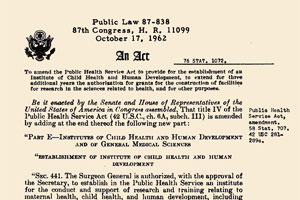 Public Law 87-838 authorizes establishment of the National Institute of Child Health and Human Development (NICHD).
Public Law 87-838 authorizes establishment of the National Institute of Child Health and Human Development (NICHD).
1963
Secretary of Health, Education, and Welfare Anthony Celebrezze approves the establishment of NICHD, with a provision that the Center for Research in Child Health and the Center for Research in Aging (established in 1956) be transferred from the Division of General Medical Sciences to the new institute.
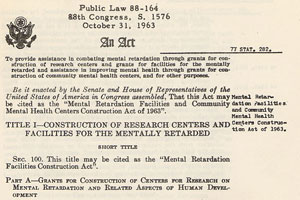 Surgeon General Luther Terry, M.D., appoints members of the National Advisory Child Health and Human Development (NACHHD) Council.
Surgeon General Luther Terry, M.D., appoints members of the National Advisory Child Health and Human Development (NACHHD) Council.
The first NACHHD Council meeting is held on November 14, 1963.
Public Law 88-164 authorizes grants to help pay for constructing research centers on mental retardation and related disabilities.
1965
A major NICHD reorganization emphasizes four program areas: reproduction, growth and development, aging, and mental retardation. At the same time, significant additions are made to the intramural program with the transfer to the NICHD of the Gerontology Branch from the National Heart Institute and of the Endocrinology Branch from the National Cancer Institute (NCI).
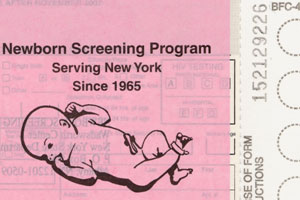 New York becomes the first state to mandate screening of all newborns for phenylketonuria (PKU), a rare disease that if left untreated causes intellectual disability (then called mental retardation), deafness, and seizures. This mandate comes after NICHD research confirms the safety and effectiveness of a simple blood test to screen for and a special diet to treat, PKU. Other states soon follow, allowing for early detection and immediate initiation of dietary therapy, which virtually eliminates PKU as a cause of intellectual disability.
New York becomes the first state to mandate screening of all newborns for phenylketonuria (PKU), a rare disease that if left untreated causes intellectual disability (then called mental retardation), deafness, and seizures. This mandate comes after NICHD research confirms the safety and effectiveness of a simple blood test to screen for and a special diet to treat, PKU. Other states soon follow, allowing for early detection and immediate initiation of dietary therapy, which virtually eliminates PKU as a cause of intellectual disability.
1967
A second reorganization of NICHD, approved by Surgeon General William Stewart, M.D., acknowledges the institute's intramural research programs by separating responsibility for intramural and extramural research, and by creating seven intramural laboratories: Gerontology Research Center, Developmental Biology Branch, Social and Behavioral Sciences Branch, Reproduction Research Branch, Laboratory of Biomedical Sciences, Behavioral Biology Branch, and Children's Diagnostic and Study Branch.
1968
DHEW Secretary Wilbur Cohen establishes the Center for Population Research within NICHD. The Center is responsible for population and reproduction research and is designated as the federal agency primarily responsible for population research and research training.
1969
Dr. Alfred Hershey—supported by the National Institute of General Medical Sciences, NCI, and NICHD—wins the Nobel Prize in Physiology or Medicine with Dr. Max Delbrück and Dr. Salvador Luria for their discoveries concerning the replication and genetic structure of viruses.
1970
NICHD's Epidemiology and Biometry Branch, created during the institute's second reorganization in 1967, becomes the Epidemiology and Biometry Research Program. The change allows the program to conduct epidemiologic, behavioral, and biometric studies relating to reproductive, maternal, and child health.
1971
 NICHD-supported researcher Craig Ramey, Ph.D., develops the Abecedarian (ABC) Project, a widely cited study that documents the long-lasting benefits of early childhood education and health care for children in poverty.
NICHD-supported researcher Craig Ramey, Ph.D., develops the Abecedarian (ABC) Project, a widely cited study that documents the long-lasting benefits of early childhood education and health care for children in poverty.
1972
 Gerald M. Edelman, M.D., Ph.D.—supported by NICHD, the National Institute of Diabetes and Digestive and Kidney Diseases, and the National Institute of Allergy and Infectious Diseases (NIAID)—wins the Nobel Prize in Physiology or Medicine with Rodney R. Porter, Ph.D., for their discoveries concerning the chemical structure of antibodies.
Gerald M. Edelman, M.D., Ph.D.—supported by NICHD, the National Institute of Diabetes and Digestive and Kidney Diseases, and the National Institute of Allergy and Infectious Diseases (NIAID)—wins the Nobel Prize in Physiology or Medicine with Rodney R. Porter, Ph.D., for their discoveries concerning the chemical structure of antibodies.
1974
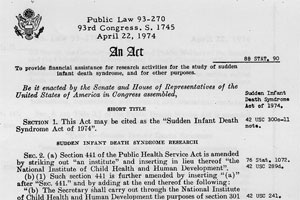 Congress passes the Sudden Infant Death Syndrome (SIDS) Act of 1974 (Public Law 93-270), directing NICHD to take the lead in SIDS research.
Congress passes the Sudden Infant Death Syndrome (SIDS) Act of 1974 (Public Law 93-270), directing NICHD to take the lead in SIDS research.
1975
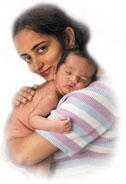 NICHD establishes the Center for Research for Mothers and Children (CRMC) as a focal point for research and research training on the special health problems of mothers and children. The Center has responsibility for increasing knowledge about pregnancy, infancy, childhood, adolescence, and adulthood and for administering grant and contract programs related to these areas.
NICHD establishes the Center for Research for Mothers and Children (CRMC) as a focal point for research and research training on the special health problems of mothers and children. The Center has responsibility for increasing knowledge about pregnancy, infancy, childhood, adolescence, and adulthood and for administering grant and contract programs related to these areas.
The Adult Development and Aging Branch and the Gerontology Research Center, with their programs to support and conduct research in the field of aging, are transferred from NICHD to the new National Institute on Aging (NIA).
Results from the NICHD's National Amniocentesis Study—led by Charles Lowe, M.D., and Duane Alexander, M.D., who would later serve as NICHD Director, show that amniocentesis is 99 percent accurate and does not significantly increase the risk of miscarriage, stillbirth, or congenital anomalies, making widespread use of the prenatal diagnostic procedure possible.
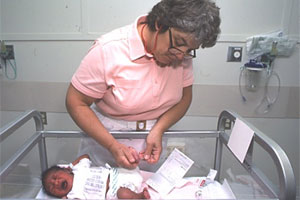 The first rudimentary test to screen for congenital hypothyroidism from a drop of infant's blood is developed. Congenital hypothyroidism is a metabolic condition resulting from the loss of thyroid function, which if left untreated in infants, causes irreversible intellectual disability. The test is the culmination of an intensive effort by NICHD-supported researcher Delbert Fisher, M.D., and his colleagues to develop sensitive methods to measure hormones in the blood and to characterize thyroid metabolism in the fetus and newborn infant.
The first rudimentary test to screen for congenital hypothyroidism from a drop of infant's blood is developed. Congenital hypothyroidism is a metabolic condition resulting from the loss of thyroid function, which if left untreated in infants, causes irreversible intellectual disability. The test is the culmination of an intensive effort by NICHD-supported researcher Delbert Fisher, M.D., and his colleagues to develop sensitive methods to measure hormones in the blood and to characterize thyroid metabolism in the fetus and newborn infant.
1977
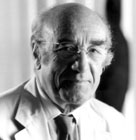 Roger Guillemin, M.D., Ph.D., and Andrew Schally, Ph.D., M.D.H.C., D.Sc.H.C.—leaders of two independent teams of researchers funded by NICHD and other organizations—win the Nobel Prize in Physiology or Medicine for their work in identifying luteinizing hormone releasing factor (now called gonadotropin-releasing hormone) and other releasing hormones produced by the hypothalamus. This discovery leads to new understanding and treatments for thyroid diseases, infertility, diabetes, types of tumors, and other disorders.
Roger Guillemin, M.D., Ph.D., and Andrew Schally, Ph.D., M.D.H.C., D.Sc.H.C.—leaders of two independent teams of researchers funded by NICHD and other organizations—win the Nobel Prize in Physiology or Medicine for their work in identifying luteinizing hormone releasing factor (now called gonadotropin-releasing hormone) and other releasing hormones produced by the hypothalamus. This discovery leads to new understanding and treatments for thyroid diseases, infertility, diabetes, types of tumors, and other disorders.
The U.S. Food and Drug Administration (FDA) approves the home pregnancy test, which was developed as a direct result of research conducted by NICHD intramural researcher Judith Vaitukaitis, M.D. She identifies the beta subunit of human chorionic gonadotropin as the earliest marker of pregnancy, which leads to the development of the first standard home pregnancy test and a monitor for response to cancer treatment.
1978
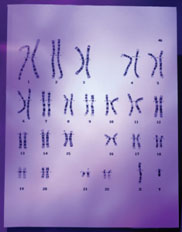 NICHD intramural researchers become the first to successfully clone a mammalian gene, a critical first step in obtaining large amounts of medically important proteins.
NICHD intramural researchers become the first to successfully clone a mammalian gene, a critical first step in obtaining large amounts of medically important proteins.
 Edward Lewis, Ph.D., supported by NICHD, publishes his seminal paper on the discovery of homeotic genes in the fruit fly. In the paper, he establishes that the order of genes on the chromosome corresponds to their order of expression along the body axis. This pioneering work leads other scientists to examine analogous genes in higher organisms, including humans, in which the gene clusters he found have been duplicated into four complexes known as the HOX genes. Dr. Lewis' work provides insight into the control of embryonic development and the causes of structural congenital anomalies. Dr. Lewis would later receive the Nobel Prize in Medicine or Physiology in 1995 for his discovery.
Edward Lewis, Ph.D., supported by NICHD, publishes his seminal paper on the discovery of homeotic genes in the fruit fly. In the paper, he establishes that the order of genes on the chromosome corresponds to their order of expression along the body axis. This pioneering work leads other scientists to examine analogous genes in higher organisms, including humans, in which the gene clusters he found have been duplicated into four complexes known as the HOX genes. Dr. Lewis' work provides insight into the control of embryonic development and the causes of structural congenital anomalies. Dr. Lewis would later receive the Nobel Prize in Medicine or Physiology in 1995 for his discovery.
1980
 NICHD-supported researcher Eric Wieschaus, Ph.D., and his colleague, Christiane Nüsslein-Volhard, Ph.D., become the first to identify all the genes involved in early pattern formation in fruit flies, which leads to the subsequent finding that the human embryo is controlled by the same genes. Dr. Wieschaus and Dr. Nüsslein-Volhard would receive the Nobel Prize in Medicine or Physiology in 1995 for this discovery.
NICHD-supported researcher Eric Wieschaus, Ph.D., and his colleague, Christiane Nüsslein-Volhard, Ph.D., become the first to identify all the genes involved in early pattern formation in fruit flies, which leads to the subsequent finding that the human embryo is controlled by the same genes. Dr. Wieschaus and Dr. Nüsslein-Volhard would receive the Nobel Prize in Medicine or Physiology in 1995 for this discovery.
1982
 NICHD intramural researcher Anil Mukherjee, M.D., Ph.D., finds that alcohol intake by pregnant monkeys restricts blood flow through the umbilical cord and causes periods of oxygen deprivation, suggesting a possible mechanism for fetal alcohol syndrome. Additional research and NICHD-supported studies in humans reveal that alcohol intake during pregnancy can cause intellectual disability in infants through a similar mechanism. These and other findings lead the U.S. Surgeon General to issue the warning now seen on alcoholic beverages that informs consumers of the risks of drinking alcohol during pregnancy.
NICHD intramural researcher Anil Mukherjee, M.D., Ph.D., finds that alcohol intake by pregnant monkeys restricts blood flow through the umbilical cord and causes periods of oxygen deprivation, suggesting a possible mechanism for fetal alcohol syndrome. Additional research and NICHD-supported studies in humans reveal that alcohol intake during pregnancy can cause intellectual disability in infants through a similar mechanism. These and other findings lead the U.S. Surgeon General to issue the warning now seen on alcoholic beverages that informs consumers of the risks of drinking alcohol during pregnancy.
1983
 NICHD grantees. Ralph Brinster, V.M.D., Ph.D., and Richard Palmiter, Ph.D., become the first scientists to transplant human genes into animals. Their accomplishment, transplanting the gene for human growth hormone into mice, provides an important new means to study the function of human genes and becomes the foundation of the new biotechnology industry.
NICHD grantees. Ralph Brinster, V.M.D., Ph.D., and Richard Palmiter, Ph.D., become the first scientists to transplant human genes into animals. Their accomplishment, transplanting the gene for human growth hormone into mice, provides an important new means to study the function of human genes and becomes the foundation of the new biotechnology industry.
Most of the United States adopts legislation that mandates all newborns be screened for congenital hypothyroidism, an action made possible by NICHD-supported research.
1984
NICHD initiates a long-term study to determine whether restricting phenylalanine in the diets of women with PKU during pregnancy could prevent neurological effects in their fetuses. The study would later find that continuing dietary therapy before and during pregnancy could prevent the problems associated with maternal PKU, allowing normal development for infants of affected mothers. Similar NICHD-supported research would later show that maintaining dietary therapy for PKU throughout life could improve overall health for those who have the condition.
1985
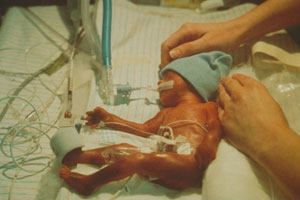 NICHD forms two research networks: the Neonatal Intensive Care Units and the Maternal-Fetal Medicine Units. These networks perform large clinical trials and provide NICHD with a faster, more effective system of evaluating neonatal intensive care and maternal-fetal treatments.
NICHD forms two research networks: the Neonatal Intensive Care Units and the Maternal-Fetal Medicine Units. These networks perform large clinical trials and provide NICHD with a faster, more effective system of evaluating neonatal intensive care and maternal-fetal treatments.
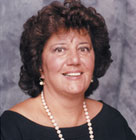 NICHD-supported researchers, led by Maria New, M.D., publish results showing that nonclassical congenital adrenal hyperplasia (CAH) is the most prevalent single-gene disorder in the general population. Researchers now use CAH to describe a family of monogenic autosomal recessive disorders. Dr. New's later findings include identifying the broad spectrum of disorders caused by CAH and developing treatments for its variant forms, including the first prenatal treatment that prevents the manifestations of CAH after birth.
NICHD-supported researchers, led by Maria New, M.D., publish results showing that nonclassical congenital adrenal hyperplasia (CAH) is the most prevalent single-gene disorder in the general population. Researchers now use CAH to describe a family of monogenic autosomal recessive disorders. Dr. New's later findings include identifying the broad spectrum of disorders caused by CAH and developing treatments for its variant forms, including the first prenatal treatment that prevents the manifestations of CAH after birth.
1987

 FDA approves the first effective vaccine against Haemophilus influenzae type b (Hib), the result of a breakthrough in vaccine development from NICHD intramural researchers John Robbins, M.D., and Rachel Schneerson, M.D. By 1996, Hib infection decreases by more than 99 percent, saving countless lives; furthermore, the incidence of Hib meningitis, once the leading cause of acquired intellectual disability, also decreases by more than 99 percent.
FDA approves the first effective vaccine against Haemophilus influenzae type b (Hib), the result of a breakthrough in vaccine development from NICHD intramural researchers John Robbins, M.D., and Rachel Schneerson, M.D. By 1996, Hib infection decreases by more than 99 percent, saving countless lives; furthermore, the incidence of Hib meningitis, once the leading cause of acquired intellectual disability, also decreases by more than 99 percent.
The National Survey of Families and Households begins the first of three waves of longitudinal data collection—with support from NICHD and NIA—to describe and understand the causes and consequences of changes in family and household structure in the United States.
1989
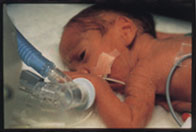 FDA approves two experimental synthetic lung surfactants for use as replacement surfactants for infants who suffer from respiratory distress syndrome (RDS), a condition that makes breathing difficult and sometimes impossible. Surfactant is the substance that coats the inner lining of the lungs and is crucial for normal breathing. The drugs later receive full FDA approval in 1990 and 1991. Prior to the availability of lung surfactant, infants with RDS have only a 5-percent chance of survival; today, infants with RDS have a 95-percent chance of survival.
FDA approves two experimental synthetic lung surfactants for use as replacement surfactants for infants who suffer from respiratory distress syndrome (RDS), a condition that makes breathing difficult and sometimes impossible. Surfactant is the substance that coats the inner lining of the lungs and is crucial for normal breathing. The drugs later receive full FDA approval in 1990 and 1991. Prior to the availability of lung surfactant, infants with RDS have only a 5-percent chance of survival; today, infants with RDS have a 95-percent chance of survival.
1990
 The NIH Amendments of 1990 (Public Law 101-613) establish the National Center for Medical Rehabilitation Research (NCMRR) within NICHD to conduct and support programs for the rehabilitation, health, and well-being of people with physical disabilities.
The NIH Amendments of 1990 (Public Law 101-613) establish the National Center for Medical Rehabilitation Research (NCMRR) within NICHD to conduct and support programs for the rehabilitation, health, and well-being of people with physical disabilities.
1991
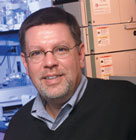 NICHD-supported researcher Stephen Warren, Ph.D., identifies the cause of Fragile X syndrome, the leading cause of inherited intellectual disability (then called mental retardation). Dr. Warren's efforts also reveal that the mutation is an entirely new inheritance mechanism, called a "triplet repeat," which gets larger in each generation and, when large enough, disrupts gene function to cause the symptoms of Fragile X.
NICHD-supported researcher Stephen Warren, Ph.D., identifies the cause of Fragile X syndrome, the leading cause of inherited intellectual disability (then called mental retardation). Dr. Warren's efforts also reveal that the mutation is an entirely new inheritance mechanism, called a "triplet repeat," which gets larger in each generation and, when large enough, disrupts gene function to cause the symptoms of Fragile X.
NICHD expands its Epidemiology and Biometry Research Program to create the Division of Epidemiology, Statistics, and Prevention Research (DESPR), part of its intramural research program. DESPR's portfolio includes research in the fields of reproduction and maternal and child health.
NICHD and 10 research universities around the United States initiate the Study of Early Child Care and Youth Development (SECCYD) to answer questions about child care and its effects on child development.
1992
 Gary S. Becker, Ph.D., supported by NICHD, wins the Bank of Sweden Prize in Economic Sciences in Memory of Alfred Nobel for having extended the domain of microeconomic analysis to a wide range of human behavior and interaction, including nonmarket behavior.
Gary S. Becker, Ph.D., supported by NICHD, wins the Bank of Sweden Prize in Economic Sciences in Memory of Alfred Nobel for having extended the domain of microeconomic analysis to a wide range of human behavior and interaction, including nonmarket behavior.
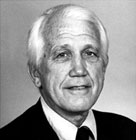 Robert Cooke, M.D., who played a pivotal role in the founding of NICHD, receives the Surgeon General's Medallion, in part for his scientific and societal contributions to benefit children, especially those with special needs.
Robert Cooke, M.D., who played a pivotal role in the founding of NICHD, receives the Surgeon General's Medallion, in part for his scientific and societal contributions to benefit children, especially those with special needs.
1993
The NIH Revitalization Act of 1993 (Public Law 103-43) mandates establishment of an intramural laboratory and clinical research program on obstetrics and gynecology within NICHD. The Act also directs NICHD to establish contraception and infertility research centers to address important research questions within these areas.
1994
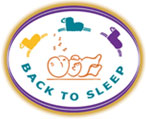 NICHD, in collaboration with public and private partners, launches the Back to Sleep campaign, a program designed to teach parents and caregivers the importance of putting babies on their backs to sleep to help reduce the risk of SIDS. Since the start of the campaign, the overall SIDS rate has dropped more than 60 percent.
NICHD, in collaboration with public and private partners, launches the Back to Sleep campaign, a program designed to teach parents and caregivers the importance of putting babies on their backs to sleep to help reduce the risk of SIDS. Since the start of the campaign, the overall SIDS rate has dropped more than 60 percent.
In response to the need for appropriate drug therapy for pediatric patients, NICHD establishes the Pediatric Pharmacology Research Unit Network. The network's mission is to facilitate and promote pediatric labeling of new drugs or drugs already on the market to ensure their safe and effective use in children.
Studies from the Pediatric AIDS Clinical Trial Group, funded by NICHD and NIAID, find that a specific regimen of zidovudine (AZT) given to a woman living with HIV during pregnancy and delivery, as well as to her infant for 6 weeks after birth, reduces perinatal HIV transmission from 25 percent to 8 percent.
NICHD and a consortium of 17 other institutions and federal agencies initiate the National Longitudinal Study of Adolescent Health (Add Health), following an ethnically, socially, and economically diverse population of adolescents to assess the behaviors and characteristics that promote good health.
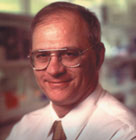 FDA approves cysteamine bitartrate for the treatment of cystinosis, a rare genetic inborn error of metabolism that can cause kidney failure and neurological damage. The approval is due in large part to the efforts of NICHD intramural researcher William Gahl, M.D., Ph.D., who demonstrated the drug's effectiveness and brought it to market as an orphan drug. Taking the drug regularly prevents any manifestations of cystinosis.
FDA approves cysteamine bitartrate for the treatment of cystinosis, a rare genetic inborn error of metabolism that can cause kidney failure and neurological damage. The approval is due in large part to the efforts of NICHD intramural researcher William Gahl, M.D., Ph.D., who demonstrated the drug's effectiveness and brought it to market as an orphan drug. Taking the drug regularly prevents any manifestations of cystinosis.
1997
NICHD launches the Milk Matters calcium education campaign, designed to educate children, teens, parents, educators, and health professionals about the importance of getting enough calcium during the childhood and teenage years to help prevent osteoporosis and fragile bones in adulthood.
NICHD announces the start of a 5-year, $27 million international collaborative network to study autism, with additional support from the National Institute on Deafness and Other Communication Disorders. The Network on the Neurobiology and Genetics of Autism, which comprises 10 Collaborative Programs of Excellence in Autism, seeks to improve the understanding of autism through research.
1998
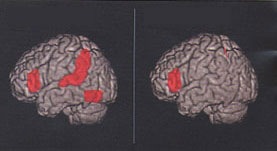 Using brain imaging technology, NICHD-funded researchers identify the brain regions underlying dyslexia.
Using brain imaging technology, NICHD-funded researchers identify the brain regions underlying dyslexia.
In the largest, most comprehensive analysis of its kind, NICHD-funded researchers find that if pregnant women with HIV deliver by elective cesarean section before they have gone into labor and before their membranes have ruptured, the risk of perinatal HIV transmission is reduced by about 50 percent.
FDA approves an NICHD-developed DTaP (diphtheria-tetanus-acellular pertussis) vaccine.
 Researchers led by NICHD grantee Ryuzo Yanagimachi, D.Sc., successfully clone five generations of female mice, making it possible for scientists to reliably produce genetically identical animals.
Researchers led by NICHD grantee Ryuzo Yanagimachi, D.Sc., successfully clone five generations of female mice, making it possible for scientists to reliably produce genetically identical animals.
1999
 NICHD-funded researchers announce the discovery of the gene for Rett syndrome, a disorder in which healthy infant girls gradually lose their language capabilities, mental functioning, and ability to interact with others. The finding has immediate implications for both the development of a test to diagnose the disorder before or at birth as well as new strategies to prevent the debilitating effects of the disease.
NICHD-funded researchers announce the discovery of the gene for Rett syndrome, a disorder in which healthy infant girls gradually lose their language capabilities, mental functioning, and ability to interact with others. The finding has immediate implications for both the development of a test to diagnose the disorder before or at birth as well as new strategies to prevent the debilitating effects of the disease.
 NICHD and the National Black Child Development Institute (NBCDI) initiate a partnership to develop a SIDS African American Outreach Initiative within the Back to Sleep campaign. NICHD and NBCDI join forces with several African American organizations, including the National Coalition of 100 Black Women, the Women in the NAACP, and the Alpha Kappa Alpha Sorority, Inc., to develop focused, community-centered information to help reduce the risk of SIDS.
NICHD and the National Black Child Development Institute (NBCDI) initiate a partnership to develop a SIDS African American Outreach Initiative within the Back to Sleep campaign. NICHD and NBCDI join forces with several African American organizations, including the National Coalition of 100 Black Women, the Women in the NAACP, and the Alpha Kappa Alpha Sorority, Inc., to develop focused, community-centered information to help reduce the risk of SIDS.
2000
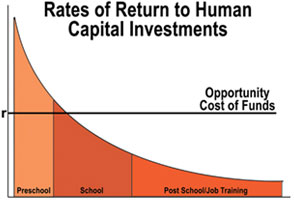 An NICHD grantee, James J. Heckman, Ph.D., of the University of Chicago, is one of two NIH researchers to receive the Bank of Sweden Prize in Economic Sciences in Memory of Alfred Nobel. Dr. Heckman receives the prize for his pioneering work in accounting for unknown factors affecting statistical samples. Much of his work has been applied to understanding how early life events contribute to a person's later earning potential and economic standing.
An NICHD grantee, James J. Heckman, Ph.D., of the University of Chicago, is one of two NIH researchers to receive the Bank of Sweden Prize in Economic Sciences in Memory of Alfred Nobel. Dr. Heckman receives the prize for his pioneering work in accounting for unknown factors affecting statistical samples. Much of his work has been applied to understanding how early life events contribute to a person's later earning potential and economic standing.
The National Reading Panel, established by NICHD, releases findings of the largest evidence-based review ever conducted of research related to how children learn to read. The independent panel concludes that the most effective way to teach children to read is through instruction that includes a combination of methods emphasizing phonemic awareness.
The Children's Health Act of 2000 (Public Law 106-310) designates NICHD as the lead organization on several research initiatives, including establishment of a pediatric research initiative, expansion of Fragile X syndrome research activities, and authorization for NICHD and a consortium of other federal agencies to conduct the National Children's Study, a longitudinal study of environmental influences on child health. The Act also made provisions for expanding research related to autism spectrum disorders.
2001
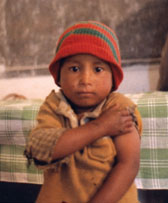 A typhoid vaccine developed by NICHD scientists shows a 91.5 percent effectiveness rate in clinical trials done in Vietnam, the highest rate reported for any typhoid vaccine.
A typhoid vaccine developed by NICHD scientists shows a 91.5 percent effectiveness rate in clinical trials done in Vietnam, the highest rate reported for any typhoid vaccine.
2002
NICHD scientists, in conjunction with the biologics firm Nabi, develop the first vaccine against Staphylococcus aureus, a major bacterial cause of infection and death in hospital patients.
 Findings from the NICHD's Women's Contraceptive and Reproductive Experiences (Women's CARE) Study reveal no life-long association between oral contraception use and a higher risk of breast cancer after a woman stops using this form of contraception. The study, which focused on women age 35 to 64, , provided scientific evidence that past or present oral contraceptive use does not significantly increase breast cancer risk.
Findings from the NICHD's Women's Contraceptive and Reproductive Experiences (Women's CARE) Study reveal no life-long association between oral contraception use and a higher risk of breast cancer after a woman stops using this form of contraception. The study, which focused on women age 35 to 64, , provided scientific evidence that past or present oral contraceptive use does not significantly increase breast cancer risk.
2003
 NICHD establishes the Center for Developmental Biology and Perinatal Medicine. The Center strives to advance fundamental and clinical knowledge about maternal health and problems of child development, such as preterm birth, intellectual and developmental disabilities, congenital and genetic disorders, fetal growth restriction, and other conditions.
NICHD establishes the Center for Developmental Biology and Perinatal Medicine. The Center strives to advance fundamental and clinical knowledge about maternal health and problems of child development, such as preterm birth, intellectual and developmental disabilities, congenital and genetic disorders, fetal growth restriction, and other conditions.
NICHD marks its 40th anniversary with several events. In addition to a scientific symposium featuring five Nobel laureates and six Lasker Award winners who were supported by NICHD, the institute establishes a Hall of Honor to recognize these individuals for their exceptional contributions to both science and human health.
2004
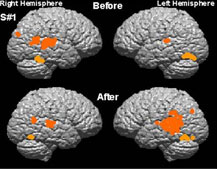 NICHD-supported researchers demonstrate that effective reading instruction not only improves reading ability, but also changes the functioning of the brain so that it reads more efficiently. The scientists used functional magnetic resonance imaging (fMRI) to observe brain functions in children during reading. With fMRI, the researchers could see that the brains of once-poor readers, as they overcame their reading disabilities, began to function like the brains of good readers. The findings show that the brain systems involved in reading respond to effective reading instruction and show increased activity in a part of the brain that recognizes words.
NICHD-supported researchers demonstrate that effective reading instruction not only improves reading ability, but also changes the functioning of the brain so that it reads more efficiently. The scientists used functional magnetic resonance imaging (fMRI) to observe brain functions in children during reading. With fMRI, the researchers could see that the brains of once-poor readers, as they overcame their reading disabilities, began to function like the brains of good readers. The findings show that the brain systems involved in reading respond to effective reading instruction and show increased activity in a part of the brain that recognizes words.
Reorganization within the NICHD's Center for Research for Mothers and Children establishes the Obstetric and Pediatric Pharmacology Branch to meet the increased demand for research leadership and support of legislation passed to ensure the safety of drugs used to treat children. The new Branch includes the NICHD Pediatric Pharmacology Research Units Network, the Obstetric-Fetal Pharmacology Research Network, and NICHD Best Pharmaceuticals for Children Act activities. The Branch provides a focus for managing efforts across the U.S. Department of Health and Human Services (HHS) to address this important topic.
Researchers in the NICHD Maternal-Fetal Medicine Units (MFMU) Network find that the risks from vaginal delivery after a prior Cesarean delivery are low and are only slightly higher than for a repeat Cesarean delivery, thus clarifying the safety of vaginal birth after Cesarean. The largest, most comprehensive study of its kind indicated that, although complications (such as rupture of the uterus and infection of the uterine lining) were possible, the risk of these complications was very low. Further, the researchers note that repeat Cesarean carries its own risks, including infection and surgical complications, and that the procedure may complicate future births.
2005
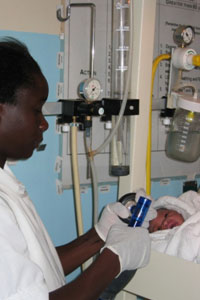 NICHD-supported researchers identify a substance—placental growth factor—in the urine of pregnant women that can be measured to predict the later development of preeclampsia, the leading cause of maternal and fetal death in the United States. This finding sets the stage for the development of a test to screen women for risk of preeclampsia.
NICHD-supported researchers identify a substance—placental growth factor—in the urine of pregnant women that can be measured to predict the later development of preeclampsia, the leading cause of maternal and fetal death in the United States. This finding sets the stage for the development of a test to screen women for risk of preeclampsia.
The Global Network for Women's and Children's Health Research, funded by NICHD and the Bill and Melinda Gates Foundation, initiates the First Breath Project to treat newborn asphyxia, a major cause of infant death in resource-poor settings.
2006
 As part of a decades-long research effort on SIDS, NICHD-funded researchers announce findings that infants who died of SIDS had abnormalities in the brainstem, a part of the brain that helps control heart rate, breathing, blood pressure, temperature, and arousal. The finding supports the concept that SIDS risk may greatly increase when an underlying predisposition combines with an environmental risk at a developmentally sensitive time in early life. Modifiable factors, such as sleep position, may provide the greatest protection against SIDS for infants with the brain abnormality.
As part of a decades-long research effort on SIDS, NICHD-funded researchers announce findings that infants who died of SIDS had abnormalities in the brainstem, a part of the brain that helps control heart rate, breathing, blood pressure, temperature, and arousal. The finding supports the concept that SIDS risk may greatly increase when an underlying predisposition combines with an environmental risk at a developmentally sensitive time in early life. Modifiable factors, such as sleep position, may provide the greatest protection against SIDS for infants with the brain abnormality.
NICHD researchers discover two genetic anomalies that lead to forms of osteogenesis imperfecta (OI), a disorder that weakens bones and may cause frequent fractures.
2007
At the recommendation of a Blue Ribbon Panel and its Board of Scientific Counselors, the NICHD Division of Intramural Research is reorganized from 22 laboratories and branches to 10 programs, along with 3 branches, 2 sections, and 3 core facilities.
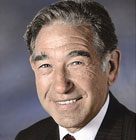 NICHD inducts Stanley Cohen, Ph.D., into its Hall of Honor for spearheading research that elucidated how cell growth and differentiation is regulated and for the discovery of epidermal growth factor. In 1986, Dr. Cohen and his colleague Dr. Levi-Montalcini earned both the Nobel Prize in Physiology or Medicine and the Albert Lasker Basic Medical Research Award for their discoveries.
NICHD inducts Stanley Cohen, Ph.D., into its Hall of Honor for spearheading research that elucidated how cell growth and differentiation is regulated and for the discovery of epidermal growth factor. In 1986, Dr. Cohen and his colleague Dr. Levi-Montalcini earned both the Nobel Prize in Physiology or Medicine and the Albert Lasker Basic Medical Research Award for their discoveries.
NIH initiates the Autism Centers of Excellence (ACE) Program, a consolidation of two existing programs, the Studies to Advance Autism Research and Treatment (STAART) and Collaborative Programs of Excellence in Autism, into a single research effort. Funding and resources for the Program are provided by NICHD, along with NIDCD, NIEHS, National Institute of Mental Health (NIMH), and National Institute of Neurological Disorders and Stroke (NINDS).
The President signs the bill renaming NICHD as the "Eunice Kennedy Shriver National Institute of Child Health and Human Development." The bill and renaming honor Mrs. Shriver's support for the establishment of the institute and her ongoing efforts on behalf of the intellectually disabled.
2008
 NICHD leads efforts to develop a research plan to advance understanding of Down syndrome and accelerate development of new treatments for the condition. The plan sets research goals for the next 10 years that build upon earlier research advances fostered by NIH.
NICHD leads efforts to develop a research plan to advance understanding of Down syndrome and accelerate development of new treatments for the condition. The plan sets research goals for the next 10 years that build upon earlier research advances fostered by NIH.
In conjunction with the institute's 45th anniversary, NICHD hosts an event to formally recognize its renaming as the Eunice Kennedy Shriver National Institute of Child Health and Human Development.
2009
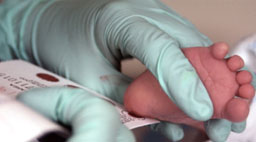 NICHD leads efforts to develop a research plan to advance the understanding of Fragile X syndrome and its associated conditions. Fragile X syndrome, which results from a mutation in a gene on the X chromosome, causes intellectual and developmental disabilities. The plan sets research priorities for each condition, including investigating the biological processes underlying all three disorders and how to better diagnose and treat them.
NICHD leads efforts to develop a research plan to advance the understanding of Fragile X syndrome and its associated conditions. Fragile X syndrome, which results from a mutation in a gene on the X chromosome, causes intellectual and developmental disabilities. The plan sets research priorities for each condition, including investigating the biological processes underlying all three disorders and how to better diagnose and treat them.
Duane Alexander, M.D., NICHD Director, announces his departure after 40 years at the institute. His tenure at NICHD saw a myriad of scientific accomplishments, ranging from the development of a vaccine against Hemophilus influenzae type b (Hib) meningitis to the dramatic decrease in the rate of mother-to-child HIV transmission in the United States.
NICHD and NIH join the newborn screening research community and the Hunter's Hope Foundation to launch the Hunter Kelly Newborn Screening Research Program. The program aims to identify new screening technologies and research management strategies for several congenital disorders and conditions.
 The NIH Director appoints Alan Guttmacher, M.D., as the acting director of NICHD. Dr. Guttmacher previously served as deputy director of the National Human Genome Research Institute.
The NIH Director appoints Alan Guttmacher, M.D., as the acting director of NICHD. Dr. Guttmacher previously served as deputy director of the National Human Genome Research Institute.
2010
Findings from an NICHD study indicate that, compared with women at a typical weight, women who have obesity before pregnancy are much more likely to have babies with problems with the heart's structure. The new findings suggest that, by losing weight before getting pregnant, women can reduce their babies' risk for congenital heart anomalies.
NIH Director Francis Collins, M.D., Ph.D., appoints Alan Guttmacher, M.D., as the new director of NICHD.
 Findings from the Fragile Families and Child Well-Being study, launched by NICHD in 1998, are published in a special issue of the journal, The Future of Children. The study results show that, when compared to married parents, unmarried couples were more likely to break up, earn less, live in poverty, rely on public and private programs, and report poor health and problems with alcohol or drugs. The study also finds that children in these families are at greater risk for abuse, poor performance at school, and behavior problems.
Findings from the Fragile Families and Child Well-Being study, launched by NICHD in 1998, are published in a special issue of the journal, The Future of Children. The study results show that, when compared to married parents, unmarried couples were more likely to break up, earn less, live in poverty, rely on public and private programs, and report poor health and problems with alcohol or drugs. The study also finds that children in these families are at greater risk for abuse, poor performance at school, and behavior problems.
NICHD researchers identify DNA variants in mothers and fetuses that seem to increase the risk for preterm labor and delivery. The scientists determine that an estimated one of every three preterm infants is born to a mother who has a "silent infection" of the amniotic fluid. They find that individual genetic variation in the immune response and attendant inflammatory hormones may account for why some pregnancies end in early labor and delivery, while others do not.
2011
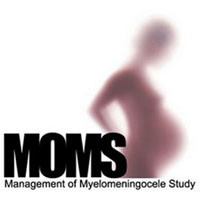 Results from an NICHD-funded study show the benefits and risks of prenatal surgery to repair the primary anomaly in the most severe form of spina bifida. Researchers in the Management of Myelomeningocele Study (MOMS) compare outcomes from the standard treatment, surgery to repair the opening in the spinal column after the baby is born, to outcomes from surgery done while the baby is still in the womb. The study shows that, despite a slight increase in risk for preterm delivery, mother and baby have better overall outcomes if the surgery is done before birth.
Results from an NICHD-funded study show the benefits and risks of prenatal surgery to repair the primary anomaly in the most severe form of spina bifida. Researchers in the Management of Myelomeningocele Study (MOMS) compare outcomes from the standard treatment, surgery to repair the opening in the spinal column after the baby is born, to outcomes from surgery done while the baby is still in the womb. The study shows that, despite a slight increase in risk for preterm delivery, mother and baby have better overall outcomes if the surgery is done before birth.
The NICHD's National Child and Maternal Health Education Program (NCMHEP) launches a continuing medical education and continuing education course, Raising Awareness: Late Preterm Birth and Non-Medically Indicated Inductions Prior to 39 Weeks. The course alerts health care providers of the impact and effects of late preterm birth and of inducing delivery for nonmedical reasons prior to 39 weeks of pregnancy. It emphasizes that birth at or after 39 weeks allows infants to reach a stage of development that best equips them for life outside of the womb.
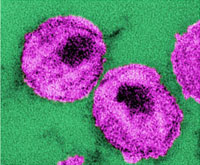 The world commemorates the 30th anniversary of the first reported cases of AIDS with several events and symposia. NICHD highlights key advances within its HIV/AIDS portfolio, which focuses on pediatric, adolescent, and maternal populations.
The world commemorates the 30th anniversary of the first reported cases of AIDS with several events and symposia. NICHD highlights key advances within its HIV/AIDS portfolio, which focuses on pediatric, adolescent, and maternal populations.
An NICHD-led study confirms the benefits of progesterone in reducing the risk of preterm birth for a certain high-risk category of women—those with a short cervix. The study also finds that infants born to these women, even if born before full term, are at lower risk of dying or having respiratory distress syndrome if progesterone is used.
2012
An NICHD-funded study suggests a possible treatment for uterine fibroid tumors, the most common noncancerous tumors in women of childbearing age. Research shows that treatment with vitamin D reduces the size of uterine fibroids in laboratory rats. Additional research is needed to determine whether human fibroid tissue responds the same way and whether the treatment is a viable option for women.
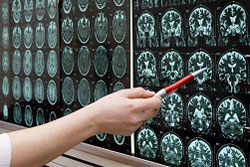 The Infant Brain Imaging Study, funded through the Autism Centers of Excellence (ACE) program, finds that patterns of brain development in the first 2 years of life are distinct in children who are later diagnosed with autism spectrum disorders (ASDs). The findings indicate that coherent, organized information pathways develop faster in typically developing children than in those later diagnosed with ASDs.
The Infant Brain Imaging Study, funded through the Autism Centers of Excellence (ACE) program, finds that patterns of brain development in the first 2 years of life are distinct in children who are later diagnosed with autism spectrum disorders (ASDs). The findings indicate that coherent, organized information pathways develop faster in typically developing children than in those later diagnosed with ASDs.
NICHD publishes its scientific Vision, identifying the most promising scientific opportunities for the institute and its partners to pursue over the next decade. The Vision statement presents the results of a 2-year collaborative process with scientists and stakeholders and outlines scientific goals for the coming decade.
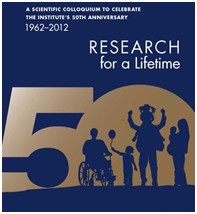 To commemorate the 50th anniversary of its founding, NICHD hosts the Research for a Lifetime scientific colloquium. Presenters include several Nobel laureates, institute advisory council members, and other distinguished guests.
To commemorate the 50th anniversary of its founding, NICHD hosts the Research for a Lifetime scientific colloquium. Presenters include several Nobel laureates, institute advisory council members, and other distinguished guests.
NICHD, with support from its collaborators, expands the Back to Sleep campaign into the Safe to Sleep® campaign to include SIDS and other sleep-related causes of infant death, such as suffocation.
2013
NICHD reorganizes one of its intramural divisions into the Division of Intramural Population Health Research.
Led by NICHD, NIH partners with national organizations to create the first online health registry on Down syndrome. DS-Connect®: The Down Syndrome Registry uses a series of questionnaires to improve the understanding of health issues specific to people with Down syndrome. The registry also serves as a resource for families, researchers, and health care providers.
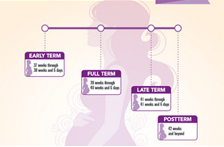 The National Child and Maternal Health Education Program (NCMHEP), led by NICHD with more than 30 maternal and child health organizations, launches the "Is it worth it?" initiative, encouraging pregnant women and health care providers to avoid elective delivery before 39 weeks of pregnancy. Although 37 weeks is considered term, NICHD research shows that critical brain and organ development occurs in weeks 37 and 38 of pregnancy. Later in the year, the American College of Obstetricians and Gynecologists and the Society for Maternal Fetal Medicine replace the label "term" with gestational age designations: early term (37 and 38 weeks), full term (39 and 40 weeks), late term (41 weeks), and postterm (42 weeks and beyond). NCMHEP's "Know Your Terms" initiative spreads the word about this change in terminology.
The National Child and Maternal Health Education Program (NCMHEP), led by NICHD with more than 30 maternal and child health organizations, launches the "Is it worth it?" initiative, encouraging pregnant women and health care providers to avoid elective delivery before 39 weeks of pregnancy. Although 37 weeks is considered term, NICHD research shows that critical brain and organ development occurs in weeks 37 and 38 of pregnancy. Later in the year, the American College of Obstetricians and Gynecologists and the Society for Maternal Fetal Medicine replace the label "term" with gestational age designations: early term (37 and 38 weeks), full term (39 and 40 weeks), late term (41 weeks), and postterm (42 weeks and beyond). NCMHEP's "Know Your Terms" initiative spreads the word about this change in terminology.
2014
Researchers in NICHD's Division of Intramural Research discover a chromosomal error that causes gigantism. The research suggests that a single gene within that chromosomal region may be largely responsible for childhood growth.
A group of researchers funded by NICHD use high-tech analysis of genetic data to diagnose endometriosis, a condition in which the tissue that lines the uterus also grows outside the uterus. This finding offers the first non-invasive diagnostic method for the condition.
NICHD-funded researchers report that a screening test for Severe Combined Immunodeficiency (SCID), also known as "bubble boy disease," reliably detects the disorder in newborns, allowing for prompt treatment and high survival rates. The Advisory Committee on Heritable Disorders in Newborns and Children later adds SCID as a core disorder on the Recommended Universal Screening Panel, which states use to determine newborn screening requirements.
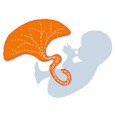 NICHD launches the Human Placenta Project, a multi-year, multidisciplinary effort to study the placenta in real time. The project aims to better understand this critical temporary organ and possibly correct problems with the placenta that may occur during pregnancy.
NICHD launches the Human Placenta Project, a multi-year, multidisciplinary effort to study the placenta in real time. The project aims to better understand this critical temporary organ and possibly correct problems with the placenta that may occur during pregnancy.
2015
NICHD-supported research shows for the first time that lithium is effective and safe for the treatment of bipolar disorder in children.
NICHD Director Dr. Alan Guttmacher announces his retirement from NICHD and NIH. Dr. Catherine Spong, deputy director of NICHD, is named acting director.
FDA approves the antibiotic meropenem for treating abdominal infections in infants 3 months of age and younger after NICHD research shows its safety and effectiveness.
2016
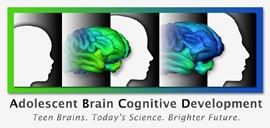 The Adolescent Brain Cognitive Development (ABCD) study launches with support from NICHD and other institutes. The ABCD study aims to determine how routine activities, such as screen time, sports, and sleep, influence the developing brain. It will rely on brain images of more than 10,000 children and teens to chart brain growth and development through adulthood.
The Adolescent Brain Cognitive Development (ABCD) study launches with support from NICHD and other institutes. The ABCD study aims to determine how routine activities, such as screen time, sports, and sleep, influence the developing brain. It will rely on brain images of more than 10,000 children and teens to chart brain growth and development through adulthood.
NIH Director Dr. Francis Collins appoints long-time NICHD grantee Dr. Diana Bianchi as NICHD Director. Dr. Bianchi's portfolio includes research on intellectual and developmental disabilities, such as Down syndrome, as well as noninvasive prenatal diagnosis and prenatal genetics. She also served on the institute's advisory committee and is board-certified in pediatrics, medical genetics, and neonatal-perinatal medicine.
For mothers with HIV, taking a three-drug antiretroviral regimen during breastfeeding essentially eliminates HIV transmission by breast milk to their infants, according to results from a large clinical trial funded by NICHD and NIAID in sub-Saharan Africa and India.
NICHD's National Center for Medical Rehabilitation Research (NCMRR) releases the NIH Plan on Rehabilitation Research (PDF 443 KB), which identifies current medical rehabilitation research activities at NIH, as well as opportunities, needs, and priorities for additional research. NCMRR will coordinate NIH-wide research activities aimed at helping those with temporary or chronic limitations in physical, cognitive, or sensory function that require rehabilitation.
2017
NICHD leads activities related to structural congenital anomalies for the Gabriella Miller Kids First Pediatric Research Program, a trans-NIH effort supported through the NIH Common Fund. The program focuses on developing tools and resources to better understand the relationship between specific structural congenital anomalies, such as neural tube defects, and childhood cancers. Its first project is the creation of a large data bank that will enable researchers to better study children with congenital anomalies, cancer, or both.
With opioid use and deaths in the United States reaching their highest numbers ever, NICHD announces a new study—Advancing Clinical trials in Neonatal Opioid Withdrawal Syndrome (ACT NOW)—to help inform clinical care of infants with neonatal opioid withdrawal syndrome (NOWS). NOWS infants experience a range of symptoms, including tremors, incessant crying and irritability, and problems sleeping, feeding, and breathing.
NICHD hosts the first meeting of the Task Force on Research Specific to Pregnant and Lactating Women. The Task Force was established by the 21st Century Cures Act to advise the Secretary of Health and Human Services on research aimed at optimizing therapies for pregnant women and nursing mothers.
2018
 NIH launches the INCLUDE (INvestigation of Co-occurring conditions across the Lifespan to Understand Down syndromE) project to address quality of life and critical health needs of people with Down syndrome. NICHD plays a leading role in the project, which also explores health conditions, such as Alzheimer’s disease and heart disease, that affect people with Down syndrome differently than the general population.
NIH launches the INCLUDE (INvestigation of Co-occurring conditions across the Lifespan to Understand Down syndromE) project to address quality of life and critical health needs of people with Down syndrome. NICHD plays a leading role in the project, which also explores health conditions, such as Alzheimer’s disease and heart disease, that affect people with Down syndrome differently than the general population.
NICHD leads the Trans-NIH Pediatric Research Consortium to harmonize activities in pediatric research across NIH, explore gaps and opportunities in the overall pediatric research portfolio, and set priorities for future activities.
NIH’s HEAL (Helping to End Addiction Long-termSM) Initiative boosts funding for research projects to stem the national opioid public crisis, including NICHD’s ACT NOW study.
The NICHD-led Task Force on Research Related to Pregnant Women and Lactating Women submits its report to the Secretary of Health and Human Services with recommendations for research on drugs and therapies used by pregnant women and nursing mothers.
The institute funds three research centers at Washington University in St. Louis, the University of Rochester in New York (in partnership with the University of Minnesota), and Pennsylvania State University to develop best practices for prevention, intervention, and treatment of child maltreatment. NICHD’s first coordinated research program on this issue will serve as a national resource for researchers and the broader community to help raise awareness and understanding of child abuse and neglect and their effects on health and well-being.
NICHD-supported research leads to U.S. Food and Drug Administration (FDA) approvals for two women’s health products: Orilissa™, the first pill for treating pain associated with endometriosis , and Annovera™, a new vaginal ring contraceptive that offers birth control protection for an entire year. The institute also launches a clinical trial to test a male contraceptive gel, called NES/T, marking the first male contraceptive technology advance in decades. A safe, highly effective and reversible method of male contraception would fill an important public health need.
FDA also approved an anti-HIV drug, Truvada®, for HIV prevention in adolescents vulnerable to HIV. The FDA’s decision was informed by an NICHD-supported study, which found that when the drug was taken appropriately by teens, it can be effective at reducing the risk for new HIV acquisitions.
2019
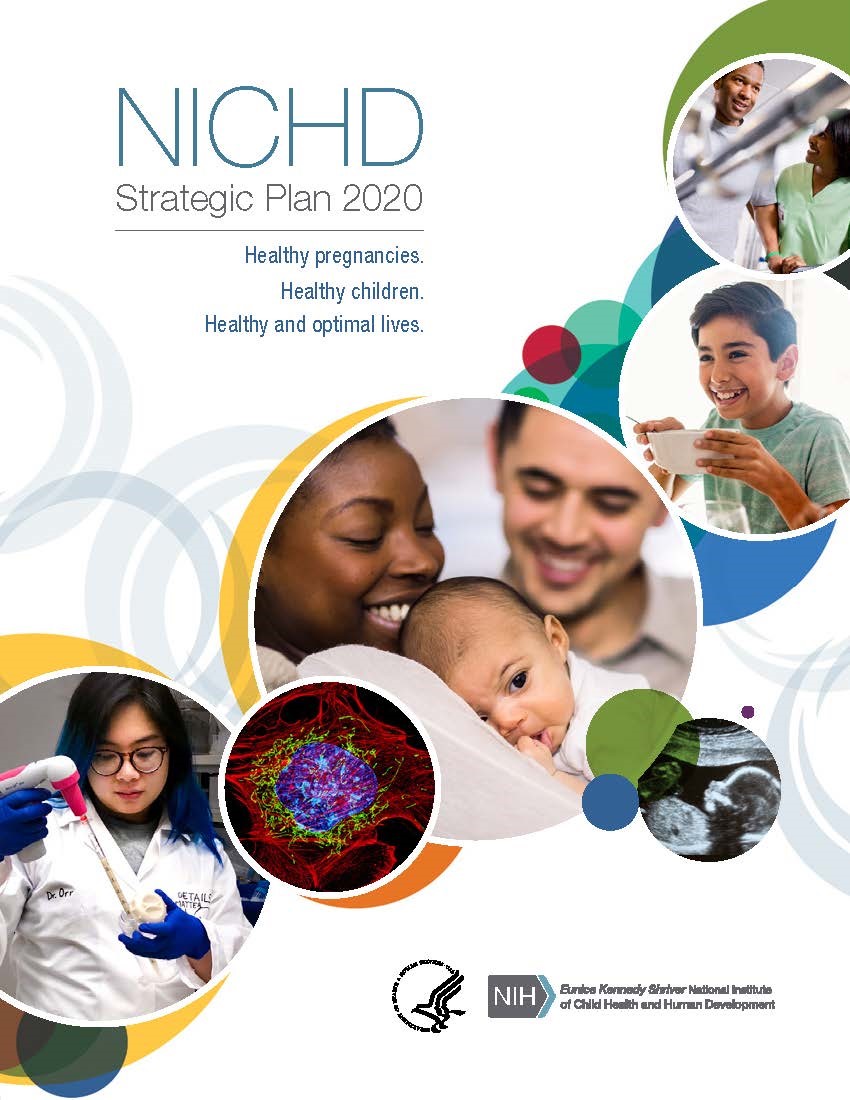 The institute publishes the NICHD Strategic Plan 2020. The plan:
The institute publishes the NICHD Strategic Plan 2020. The plan:
- Outlines scientific research goals and objectives, aspirational goals, and scientific stewardship and accountability activities.
- Reaffirms NICHD’s commitment to research and training for healthy pregnancies, healthy children, and healthy and optimal lives.
- Encourages multidisciplinary teams of scientists to work together to address key public health priorities within institute mission areas.
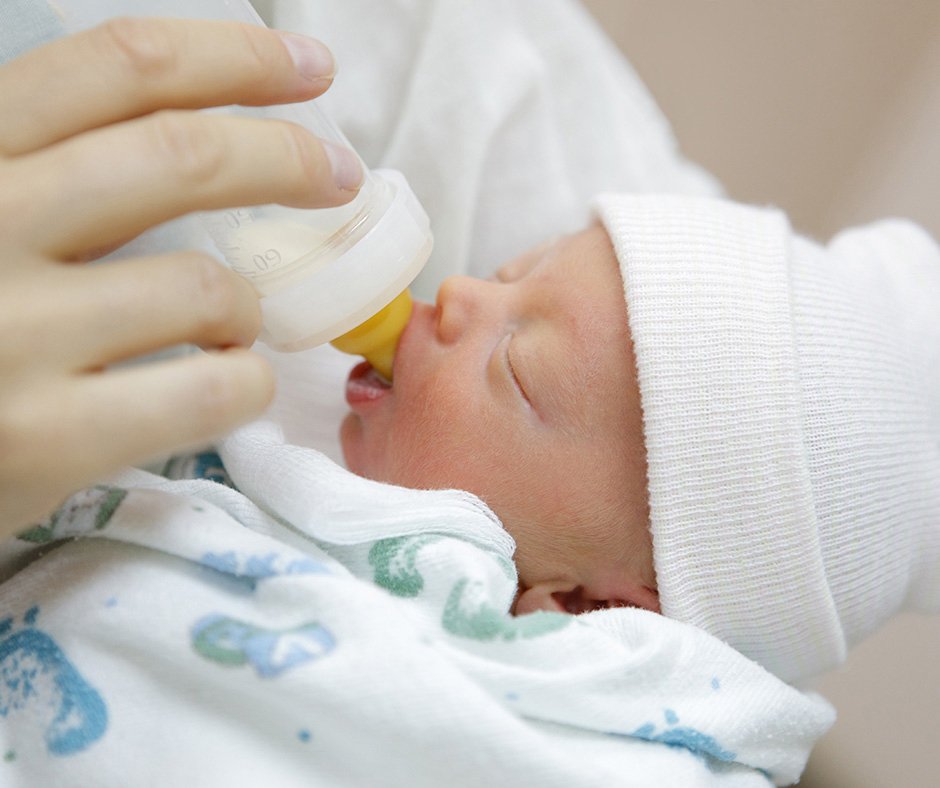 NICHD launches the Advancing Clinical Trials in Neonatal Opioid Withdrawal (ACT NOW) study, with co-funding from the NIH Environmental influences on Child Health Outcomes (ECHO) Program. The study is among several NICHD-led projects within the NIH Helping to End Addiction Long-term® Initiative, or NIH HEAL Initiative®, a trans-agency effort to speed scientific solutions to stem the national opioid public health crisis. In addition to studies on opioids during pregnancy, NICHD supports efforts to identify alternatives to opioids for treating pain conditions in women of reproductive age.
NICHD launches the Advancing Clinical Trials in Neonatal Opioid Withdrawal (ACT NOW) study, with co-funding from the NIH Environmental influences on Child Health Outcomes (ECHO) Program. The study is among several NICHD-led projects within the NIH Helping to End Addiction Long-term® Initiative, or NIH HEAL Initiative®, a trans-agency effort to speed scientific solutions to stem the national opioid public health crisis. In addition to studies on opioids during pregnancy, NICHD supports efforts to identify alternatives to opioids for treating pain conditions in women of reproductive age.
An NICHD-funded study develops implants that partially restored limb function in rats with spinal cord injuries. Another NICHD-supported study successfully uses sperm from frozen macaque testicular tissue to produce a pregnancy that led to healthy, live offspring. These and other findings reinforce the importance of basic research and animal models research to advance our understanding of human health.
 NICHD leads activities to improve maternal health in the United States after multiple studies report that the U.S. has the highest rate of maternal mortality of any developed country. Efforts include the following:
NICHD leads activities to improve maternal health in the United States after multiple studies report that the U.S. has the highest rate of maternal mortality of any developed country. Efforts include the following:
- The Secretary of the Department of Health and Human Services (HHS) renews the NICHD-led Task Force on Research Specific to Pregnant Women and Lactating Women (PRGLAC)—established in 2016 as part of the 21st Century Cures Act—for 2 additional years. The Task Force identified gaps in knowledge and research on safe and effective therapies for pregnant and lactating women and, in 2018, submitted recommendations for improving research and outcomes for these populations. The additional time will enable PRGLAC members to provide implementation guidance for their recommendations.
- NICHD Director Dr. Diana W. Bianchi and colleagues call on the scientific community to increase research on maternal morbidity and mortality, especially among women of color, who are disproportionately affected. Their message, published in the American Journal of Obstetrics and Gynecology, suggests additional research and better data collection methods to understand and track progress on maternal health outcomes.
- In addition to highlighting NICHD’s contributions to maternal health research throughout its history, including a podcast on maternal deaths and childbirth complications, the institute hosts two national workshops to begin a dialogue between community members and the organizations and agencies that serve them and to identify organizational changes, such as data collection standards, that could improve maternal health and prevent maternal mortality.
NICHD grantee Esther Duflo, Ph.D., and Michael Kremer, Ph.D., who was supported by NICHD early in his career, share the 2019 Sveriges Riksbank Prize in Economic Sciences in Memory of Alfred Nobel with colleague Abhijit Banerjee, Ph.D., for their work in development economics. Their work includes creation of an experiment-based approach that uses more precise questions to obtain reliable answers on how to fight global poverty.
Read more about selected NICHD research advances of 2019.
2020
A study conducted through NICHD’s Global Network for Women’s and Children’s Health Research finds that low-dose aspirin therapy could reduce preterm birth risk and its associated morbidities in first-time mothers living in resource-poor settings. The findings support the safety and efficacy of this cost-effective strategy for widespread use in developing countries.

NICHD marks 10 years of Human-Animal Interaction research, in collaboration with WALTHAM® PetCare Science Institute, a division of Mars, to explore and document the impact of interactions between animals and their human companions.
 In March 2020, the World Health Organization declares SARS-CoV-2—also known as coronavirus 2019 or COVID-19—a pandemic, changing the world almost overnight. NICHD begins participating in and leading many NIH- and HHS-wide activities related to COVID-19, including those in the institute’s populations of interest: pregnant and lactating women, infants and children, and people with disabilities. As NICHD staff and researchers adjust to rapidly changing situations, they remain committed to advancing COVID-19 research, from calling attention to the disproportionate toll that the pandemic has on people with disabilities, to finding that women in their third trimester of pregnancy are unlikely to pass the infection to their newborns, to evaluating drugs prescribed to treat COVID-19 in infants, children, and teens. The institute launches the COVID-19 Research and NICHD website to document and share its pandemic-related activities.
In March 2020, the World Health Organization declares SARS-CoV-2—also known as coronavirus 2019 or COVID-19—a pandemic, changing the world almost overnight. NICHD begins participating in and leading many NIH- and HHS-wide activities related to COVID-19, including those in the institute’s populations of interest: pregnant and lactating women, infants and children, and people with disabilities. As NICHD staff and researchers adjust to rapidly changing situations, they remain committed to advancing COVID-19 research, from calling attention to the disproportionate toll that the pandemic has on people with disabilities, to finding that women in their third trimester of pregnancy are unlikely to pass the infection to their newborns, to evaluating drugs prescribed to treat COVID-19 in infants, children, and teens. The institute launches the COVID-19 Research and NICHD website to document and share its pandemic-related activities.
In September 2020, NICHD continues advancing maternal morbidity and mortality research across NIH and HHS by taking a lead role in the trans-NIH Implementing a Maternal health and PRegnancy Outcomes Vision for Everyone (IMPROVE) initiative, which supports research on preventable causes of maternal death to improve the health of mothers before, during, and after pregnancy.
 In October 2020, the trans-NIH INCLUDE (INvestigation of Co-occurring conditions across the Lifespan to Understand Down syndromE) project awards more than $60 million to support more than 40 new research projects on Down syndrome. Because of the project’s focus on critical health and quality-of-life needs for individuals with Down syndrome, NICHD plays a key role in INCLUDE and funds the INCLUDE Data Hub.
In October 2020, the trans-NIH INCLUDE (INvestigation of Co-occurring conditions across the Lifespan to Understand Down syndromE) project awards more than $60 million to support more than 40 new research projects on Down syndrome. Because of the project’s focus on critical health and quality-of-life needs for individuals with Down syndrome, NICHD plays a key role in INCLUDE and funds the INCLUDE Data Hub.
Read more about selected NICHD research advances of 2020.
 BACK TO TOP
BACK TO TOP